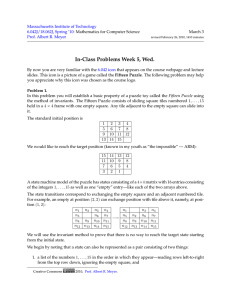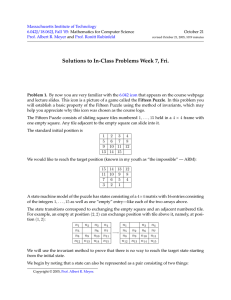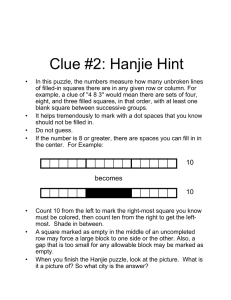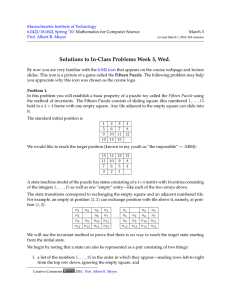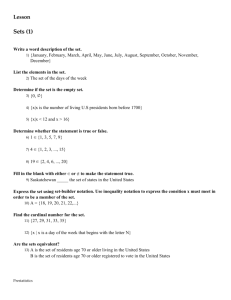Massachusetts Institute of Technology 6.042J/18.062J, Fall ’05 Prof. Albert R. Meyer
advertisement
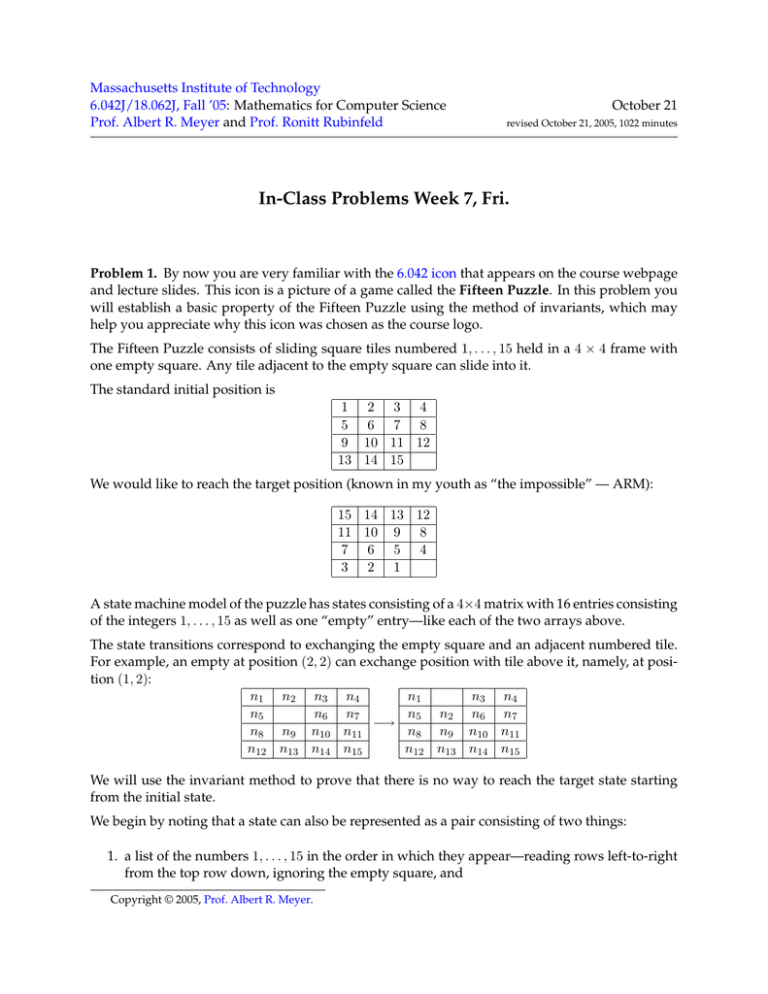
Massachusetts Institute of Technology 6.042J/18.062J, Fall ’05: Mathematics for Computer Science Prof. Albert R. Meyer and Prof. Ronitt Rubinfeld October 21 revised October 21, 2005, 1022 minutes In­Class Problems Week 7, Fri. Problem 1. By now you are very familiar with the 6.042 icon that appears on the course webpage and lecture slides. This icon is a picture of a game called the Fifteen Puzzle. In this problem you will establish a basic property of the Fifteen Puzzle using the method of invariants, which may help you appreciate why this icon was chosen as the course logo. The Fifteen Puzzle consists of sliding square tiles numbered 1, . . . , 15 held in a 4 × 4 frame with one empty square. Any tile adjacent to the empty square can slide into it. The standard initial position is 1 2 3 4 5 6 7 8 9 10 11 12 13 14 15 We would like to reach the target position (known in my youth as “the impossible” — ARM): 15 14 13 12 11 10 9 8 7 6 5 4 3 2 1 A state machine model of the puzzle has states consisting of a 4×4 matrix with 16 entries consisting of the integers 1, . . . , 15 as well as one “empty” entry—like each of the two arrays above. The state transitions correspond to exchanging the empty square and an adjacent numbered tile. For example, an empty at position (2, 2) can exchange position with tile above it, namely, at posi­ tion (1, 2): n1 n2 n3 n4 n1 n3 n4 n5 n6 n7 n5 n2 n6 n7 −→ n8 n9 n10 n11 n8 n9 n10 n11 n12 n13 n14 n15 n12 n13 n14 n15 We will use the invariant method to prove that there is no way to reach the target state starting from the initial state. We begin by noting that a state can also be represented as a pair consisting of two things: 1. a list of the numbers 1, . . . , 15 in the order in which they appear—reading rows left­to­right from the top row down, ignoring the empty square, and Copyright © 2005, Prof. Albert R. Meyer. 2 In­Class Problems Week 7, Fri. 2. the coordinates of the empty square—where the upper left square has coordinates (1, 1), the lower right (4, 4). (a) Write out the “list” representation of the start state and the “impossible” state. Let L be a list of the numbers 1, . . . , 15 in some order. A pair of integers is an out­of­order pair in L when the first element of the pair both comes earlier in the list and is larger, than the second element of the pair. For example, the list 1, 2, 4, 5, 3 has two out­of­order pairs: (4,3) and (5,3). The increasing list 1, 2 . . . n has no out­of­order pairs. Let a state, S, be a pair (L, (i, j)) described above. We define the parity of S to be the mod 2 sum of the number, p(L), of out­of­order pairs in L and the row­number of the empty square, that is the parity of S is p(L) + i (mod 2). (b) Verify that the parity of the start state and the target state are different. (c) Show that the parity of a state is invariant under transitions. Conclude that “the impossible” is impossible to reach. By the way, if two states have the same parity, then in fact there is a way to get from one to the other. If you like puzzles, this is a good one to think about on your own about after class. In­Class Problems Week 7, Fri. 3 Problem 2. The most straightforward way to compute the bth power of a number, a, is to multiply a by itself b times. This of course requires b − 1 multiplications. There is another way to do it using considerably fewer multiplications. This algorithm is called Fast Exponentiation: Given inputs a ∈ R, b ∈ N, initialize registers x, y, z to a, 1, b respectively, and repeat the following sequence of steps until termination: • if z = 0 return y and terminate • r := remainder(z, 2) • z := quotient(z, 2) • if r = 1, then y := xy • x := x2 We claim this algorithm always terminates and leaves y = ab . (a) Model this algorithm with a state machine, carefully defining the states and transitions. (b) Let d ::= ab . Verify that the following predicate, P , is an invariant: P ((x, y, z)) ::= [yxz = d]. (c) Prove that the algorithm is partially correct: if it halts, it does so with y = d. (d) Prove that the algorithm terminates. (e) In fact, prove that it requires at most 2 log2 b multiplications for the Fast Exponentiation algo­ rithm to compute ab for b > 1.
